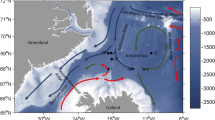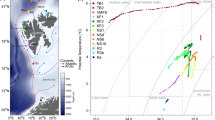Abstract
The life cycles and distribution of three dominant copepods,Calanoides acutus, Calanus simillimus andRhincalanus gigas were studied from the “Discovery” collections in the Scotia Sea earlier this century.C. simillimus is a sub-Antarctic species which mates in the top 250 m mainly in spring. The rapid development of the summer generation may allow a second mating period and a smaller second generation to appear in late summer.C. simillimus remains in the surface layers for a longer period thanCalanoides acutus orR. gigas, and its depth distribution is bimodal throughout the winter.R. gigas is most abundant in sub-Antarctic waters to the north of the Polar Front. It mates within the top 750 m later in spring, and development seems less synchronised than that of the other two species, with egg laying and the growth season being more protracted. Stages CIII and CIV are reached by the first autumn and further development resumes very early the following spring. It is not clear whether the majority then spawn or whether a further year may be needed to complete the life cycle. The predominantly Antarctic species,C. acutus mates below 750 m in middle to late winter and the summer generation develops rapidly to either CIV or CV. Its lifespan seems typically 1 yr, but some of the CVs which fail to moult and spawn in winter survive into their second summer, and their subsequent fate is uncertain. The cold-water speciesCalanus propinquus is comparatively rare in the Scotia Sea and aspects of its distribution and life cycle are briefly described for comparison. Regional variations in the timing of these events were apparent forC. simillimus and possiblyCalanoides acutus, but were not seen inR. gigas. Their geographic and vertical separation, together with their asynchronous life cycles support the concept of habitat-partitioning of these dominant herbivores.
Similar content being viewed by others
Literature cited
Andrews, K. J. H. (1966). The distribution and life-history ofCalanoides acutus (Giesbrecht). ‘Discovery’ Rep. 34: 1–116
Anonymous (1930) Discovery investigations station list, 1927–1929. ‘Discovery’ Rep. 3: 1–132
Anonymous (1932). Discovery investigations station list, 1929–1931. ‘Discovery’ Rep. 4: 1–232
Anonymous (1941). Discovery investigations station list, 1931–1933. ‘Discovery’ Rep. 21: 1–226
Anonymous (1942). Discovery investigations station list, 1933–1935. ‘Discovery’ Rep. 22: 1–196
Anonymous (1944). Discovery investigations station list, 1935–1937. ‘Discovery’ Rep. 24: 1–196
Anonymous (1957). Discovery investigations station list, 1950–1951. ‘Discovery’ Rep. 28: 299–398
Atkinson, A. (1989a). Distribution of six major copepod species around South Georgia in early summer. Polar Biol. 9: 353–363
Atkinson, A. (1989b). Distribution of six major copepod species around South Georgia during an austral winter. Polar Biol. 10: 81–88
Atkinson, A., Peck, J. M. (1988). A summer-winter comparison of zooplankton in the oceanic area around South Georgia. Polar Biol. 8: 463–473
Conover, R. J. (1988). Comparative life histories in the generaCalanus andNeocalanus in high latitudes of the northern hemisphere. Hydrobiologia 167/168: 127–142
Chojnacki, J., Weglenska, T. (1984). Periodicity of composition, abundance, and vertical distribution of summer zooplankton (1977/1978) in Ezcurra Inlet, Admiralty Bay (King George Island, South Shetland). J. Plankton Res. 6: 997–1017
Foxton, P. (1956). The distribution of the standing crop of zooplankton in the Southern Ocean. ‘Discovery’ Rep. 28: 191–236
Gordon, A. L. (1967). Structure of Antarctic waters between 20°W and 170°W. Antarctic Map Folio Ser. 6: 1–10
Hardy, A. C., Gunther, E. R. (1935). The plankton of the South Georgia whaling grounds and adjacent waters, 1926–1927. ‘Discovery’ Rep. 21: 261–356
Hart, T. J. (1942). Phytoplankton periodicity in Antarctic surface waters. ‘Discovery’ Rep. 8: 1–268
Hempel, G. (1985). On the biology of polar seas, particularly the Southern Ocean. In: Gray, J. S., Christiansen, M. E. (eds.) Marine biology of polar regions and effects of stress on marine organisms. John Wiley & Sons Ltd., London, p. 3–33
Hirche, H. G. (1983). Overwintering ofCalanus finmarchicus andCalanus helgolandicus. Mar. Ecol. Prog. Ser. 11: 281–290
Hopkins, T. L. (1971). Zooplankton standing crop in the Pacific sector of the Antarctic. Antarctic Res. Ser. 17: 347–362
Huntley, M. E., Escritor, F. (in press). Dynamics ofCalanoides acutus (Copepoda: Calanoida) in Antarctic coastal waters. Deep-Sea Res.
Kemp, S., Hardy, A. C., Mackintosh, N. A. (1929). Discovery investigations: objects, equipment and methods. ‘Discovery’ Rep. 1: 141–232
Mackintosh, N. A. (1937). The seasonal circulation of the Antarctic macroplankton. ‘Discovery’ Rep. 16: 365–412
Marin, V. (1986) Distribution and life cycle of three Antarctic copepods (Calanoides acutus, Calanus propinquus andRhincalanus gigas). PhD thesis. University of California, San Diego
Marin, V. (1987). The oceanographic structure of the eastern Scotia Sea: Part VI — Distribution of copepod species in relation to hydrography in 1981. Deep-Sea Res. 34: 105–121
Marin, V. (1988a). Independent life cycles: an alternative to the asynchronism hypothesis for Antarctic calanoid copepods. Hydrobiologia 167/168: 161–168
Marin, V. (1988b). Qualitative models of the life cycles ofCalanoides acutus, Calanus propinquus andRhincalanus gigas. Polar Biol. 8: 439–446
Matthews, J. B. L. (1968). On the acclimatization ofCalanus finmarchicus (Crustacea, Copepoda) to different temperature conditions in the North Atlantic. Sarsia 84: 371–382
Miller, C. B., Frost, B. W., Batchelder, H. P., Clemons, M. J., Conway, R. E. (1984). Life histories of large, grazing copepods in a subarctic ocean gyre:Neocalanus plumchrus, Neocalanus cristatus andEucalanus bungii in the northeast Pacific. Prog. Oceanogr. 13: 201–243
Ommanney, F. D. (1936).Rhincalanus gigas (Brady), a copepod of the southern macroplankton. ‘Discovery’ Rep. 13: 277–384
Ottestad, P. (1932). On the biology of some southern Copepoda. Halvråd. Skr. 5: 1–61
Philippon, M. R. (1972). Doctorate thesis. University of Provence, Marseille, France
Raymont, J. E. G. (1983). Plankton and productivity in the oceans. 2nd ed. Vol. 2. Zooplankton. Pergamon, New York
Sievers, H. A., Nowlin, W. D. (1984). The stratification and water masses at Drake Passage. J. geophys. Res. 83: 10483–10514
Sievers, H. A., Nowlin, W. D. (1988). Upper-ocean characteristics in Drake Passage and adjoining areas of the Southern Ocean, 40 W–95 W. In: Sahrhage, D. (ed.) Antarctic ocean and resources variability. Springer-Verlag, Berlin, p. 57–80
Vervoort, W. (1965). Notes on the biogeography and ecology of free-living marine copepoda. In: Oye, P. van, Mieghem, J. van. (eds.) Biogeography and ecology in Antarctica. Junk, The Hague, p. 381–401
Vladimirskaya, Ye. V. (1978). Age composition of winter populations of abundant copepod species in the southern part of the Scotia Sea. Oceanology, Wash. 18: 202–204
Voronina, N. M. (1970). Seasonal cycles of some common Antarctic copepod species. In: Holdgate, M. W. (ed.) Antarctic ecology. Vol. 1. Academic Press, London, p. 162–172
Voronina, N. M. (1972). The spatial structure of interzonal copepod populations in the Southern Ocean. Mar. Biol 15: 336–343
Voronina, N. M. (1978). Variability in ecosystems. In: Charnock, H., Deacon, G. E. R. (eds.) Advances in oceanography. Plenum Press, New York, p. 221–243
Voronina, N. M., Vladimirskaya, Ye. V., Zmijevskaya, M. I. (1978). Seasonal variations in the age composition and vertical distribution of common zooplankton species in the Southern Ocean. Oceanology, Wash. 18: 335–338
Ward, P. (1989). The distribution of zooplankton in an Antarctic fjord at South Georgia during summer and winter. Antarctic Sci. 1: 141–150
Whitworth, T. (1980). Zonation and geostrophic flow of the antarctic circumpolar current at Drake Passage. Deep-Sea Res. 27: 497–507
Williams, R. (1988). Spatial heterogeneity and niche differentiation in oceanic zooplankton. Hydrobiologia 167/168: 151–160
Zmijewska, M. I. (1979). Copepoda (Calanoida) from Prydz Bay (Antarctica, Indian Ocean Sector). Pol. polar. Res. (Warsaw) 4: 33–47
Zmijewska, M. I. (1987). Horizontal and vertical distribution of Copepoda in the southern part of the Drake Passage and in the Bransfield Strait (BIOMASS-SIBEX) 1983/1984. Pol. polar Res. (Warsaw) 8: 381–390
Author information
Authors and Affiliations
Additional information
Communicated by J. Mauchline, Oban
Rights and permissions
About this article
Cite this article
Atkinson, A. Life cycles ofCalanoides acutus, Calanus simillimus andRhincalanus gigas (Copepoda: Calanoida) within the Scotia Sea. Mar. Biol. 109, 79–91 (1991). https://doi.org/10.1007/BF01320234
Accepted:
Issue Date:
DOI: https://doi.org/10.1007/BF01320234




